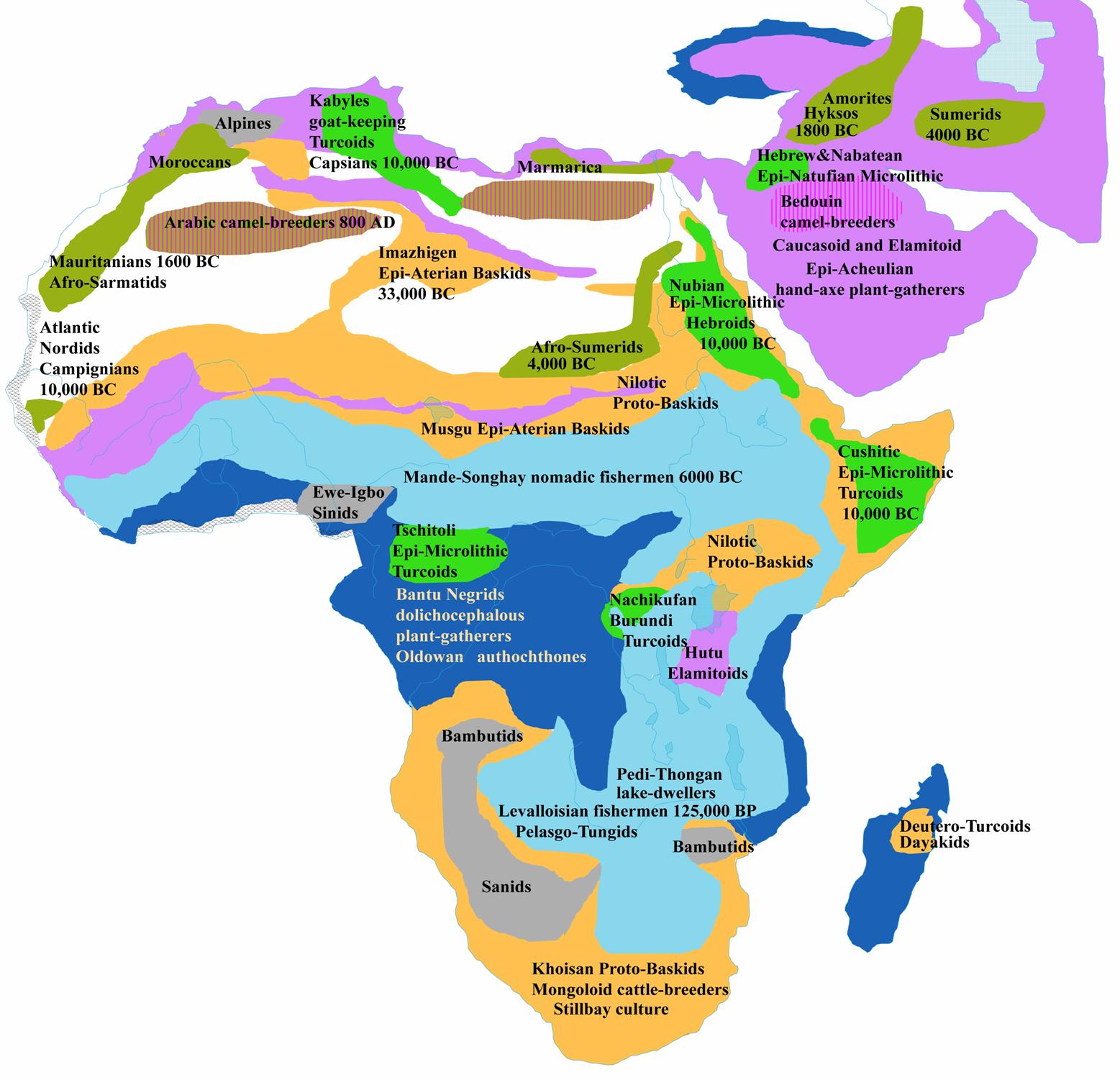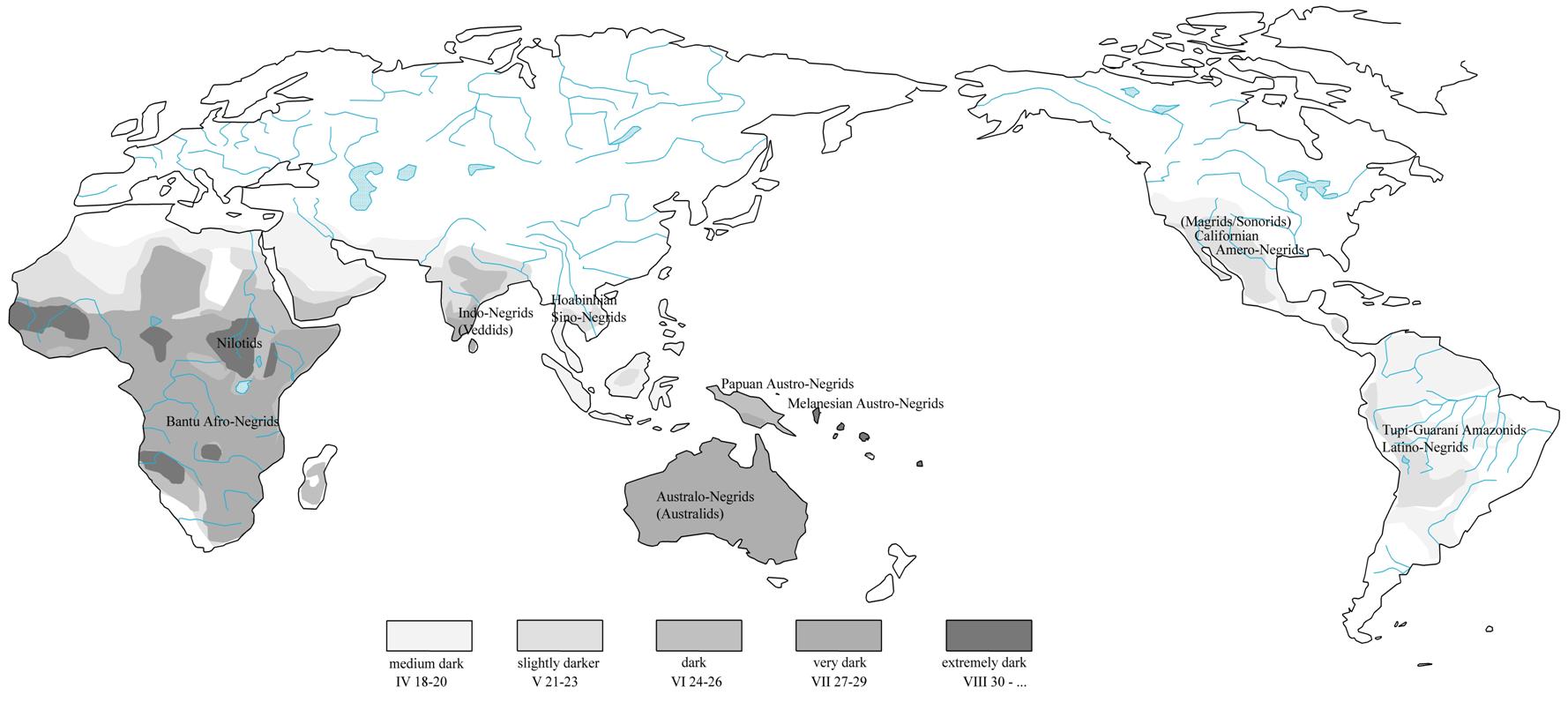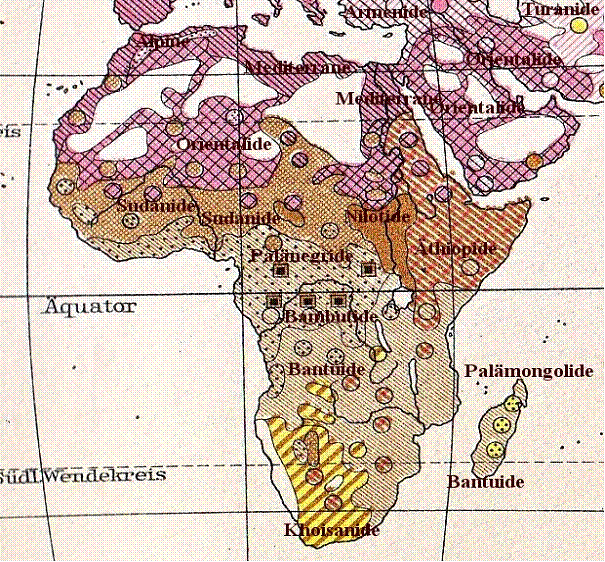|
Map 6. The subcategorisation
of African races revisited (from
Pavel Bě1íček: The
Differential Analysis of the Wordwide
Human Varieties. Prague 2018, Map 6, p. 18) |
||||
|
Map 3. Indices
of black-skinned melanodermia in Negrids (after R. Biasutti) (Pavel Bělíček: The Differential Analysis of the
Wordwide Human Varieties.,Prague 2018, p. 41, Map 12) |
||||
|
|
The Classification of African Races
The problem of
African racial taxonomy was tackled by many authors but only few of them have
codified staple authoritative types of
anthropological classification. The American physician Samuel G. Morton compared the African Negro
with the Oceanic-Negro and divided African blacks into groups of genuine
Negroes, Hottentots and Kaffirs (Kafrids).1 The British evolutionist
Thomas Henry Huxley classified African populations in varieties of Negroids, Melanochroi (Mediterranids), Bushmen and Xanthochroi
(Berber whites).2 Carleton Coon proposed partitioning into Congoids (Bantu blacks), Capoids
(Khoisanids) and Caucasoids
(Orientalids in The decisive influence was exerted only by two
leading anthropologists, Egon von Eickstedt and Renato Biasutti. Eickstedt’s Rassenkunde3 offered the
following classification of anthropological types (Map 1) that prevail on the
African continent: I. Negrid-Europid contact zone: Äthiopide, II.
Bush and savannah zone: Nilotide, Sudanide, Kafride, III.
Rainforest zone: Palänegride Altrassen: II. Khoisanide: (sub-forms: Khoide,
Sanide). Eickstedt’s
considerations on African racial groups influenced detailed maps of their
distribution in surveys published by his Italian colleague R. Biasutti. Biasutti’s taxonomy
put forward an independent nomenclature that counted with the following
subgroups (Map 2): Negroidi: Pigmidi, Cafridi, Nilotidi, Steatopigidi, Sudanidi, Congolidi, Europidi: Orientalidi, Berberidi, Armenidi, Mediterranidi, Nordidi var. Atlantica, Razze
derivate: Saharidi, Etiopidi, Malgassidi,
Indonesidi.4 Pygmids: a term for
African pygmy tribes that may have descended from the dwarfish Sanids. Their pigmentation seems to be a secondary trait,
since African Pygmies are born as red-skinned babies. Their African origin
does not refute the evidence that most Chadic and
Nigerian semi-Pygmids exhibit linguistic features
of the Sinid macrofamily
of Asiatic descent. The ethnic group Ewe-Igbo in Negrillo: a
misleading term for the dwarfish Negroid race of central and southern †Steatopygids, Khoisanids: these terms of Biasutti’s racial taxonomy intermingle two heterogeneous
and incompatible nationalities permeating one another in the †Capoids: a
catch-all term5 for several racial groups
in the vicinity of the Cap of Good Hope in †Kafrids: a
derogatory racial term for Zulus and East African tribes introduced by R. Biasutti. It represents a colonial exonym
for local Zulu-Kaffir servants and strikes as resemblant
to the exonymous denominations of ‘Hottentot’ for Namibian Khoids
and ‘Bushman’ for Sanids. On the other hand, its
chief merit consists in distinguishing the East African lake-dwellers from
Bantu ethnic groups and other branches of the Niger-Congo family. They form a
continuation of prehistoric Levalloisian and ‘Pre-Aurignacian’
nomadic fishermen living in conico-cylindrical
roundhouses. Their real core is formed by Pele-Thongan
tribes classed as Tungids. The sites of their
Levalloisian technology and culture spanned from
Map 1.
Eickstedt’s map of African races |
Map 2.
The traditional classification
of African races (after R. Biasutti) (from
Pavel Bě1íček: The
Differential Analysis of the Wordwide
Human Varieties. Prague 2018, Map 2, p. 9) The
Subdivision of African Negrids
Archaeological evidence splits African Negrids
into three principal generations: (1) Oldowans (2.5
mya), (2) Sangoans
(130,000 BP) and (3) Lumpembans (40,000 BP). Oldowans prevailed in Palaeo-Negrids.
In isolated refuges of European Palaeo-Negrids. The first European colonists were a
progeny of Homo erectus (Tautavel man in Zambesids. The Scottish Old Black Breed exhibited deep-set eyes,
heavy brow ridges and further archaic tendencies similar to African Palaeo-Negrids. Their proto-type was classified by George
Montandon as Homo s. palaeniger. His characteristic features were deep-set eyes,
rectangular eye-holes, heavy brow arches, heavy jaws, very wide faces,
sloping foreheads, receding chins, strong hairiness and bluish black skin
colour. Such tendencies appeared inconsistently also in South and The current results of
population genetics imply that the earliest ancestors concentrated around the
original homeland laying somewhere in
The tribal structure of African blacks may be reconstructed according
to frequency in chains of ethnonyms and linguonym. Table 1 takes
efforts to render a rough subcategorisation of African
tribes without pretending an exhaustive depth of taxonomic considerations.
Its right-hand column suggests frequency rates ruling among three principal
branches of black people. The main conclusion is that Oldowans
lacked a permanent tribal ethnonymy because the
African, Melanesian, Australian, Chinese and Latino-American Negrids bear different tribal names. African blacks
created their tribal ethnonyms later in the era of
the Sangoan culture.
Table 1.
The division of African Negrids in the light of ethnonymic
routes Extract from Pavel Bě1íček: The
Differential Analysis of the Wordwide
Human Varieties. Prague 2018, pp. 7-23 |
|
|




